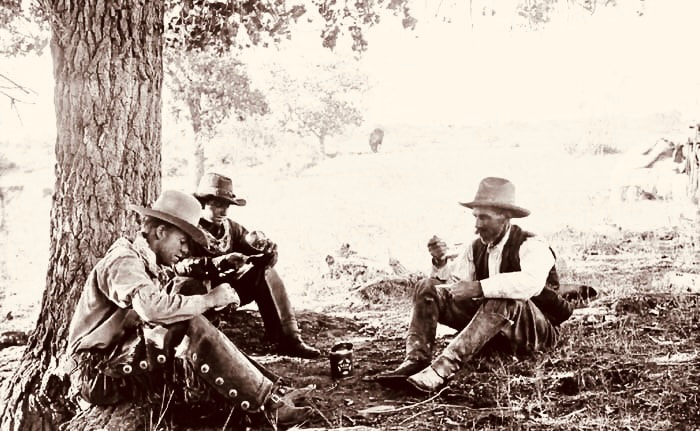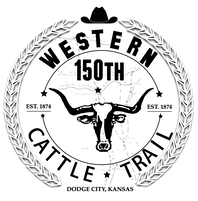|
According to Joseph G. McCoy, life on the trail was normally fairly boring for cowboys, but things picked up once they got to town. McCoy wrote a book called Historic Sketches of the Cattle Trails of the West and Southwest, and published it through Ramsey, Millett & Hudson in 1874.
McCoy describes life in camp as “routine and dull,” saying that “...food is largely of the regulation order, but a feast of vegetables he wants and must have, or scurvy would ensue. Onions and potatoes are his favorites, but any kind of vegetables will disappear in haste when put within his reach. In camp, on the trail, on the ranch in Texas, with their countless thousands of cattle, milk and butter are almost unknown, not even milk or cream for the coffee is had. Pure shiftlessness and the lack of energy are the only reasons for this privation.... “They sleep on the ground, with a pair of blankets for bed and cover. No tent is used...The warm water of the branch or the standing pool is dank....” McCoy says things change dramatically at the end of the trail, once a herd is sold and the cowboys are paid: “It’s a day of rejoicing to the cow-boy...for then he can go free and have a jolly time....Straightway after settling with their employers the barber shop is visited, and three to six month’s growth of hair is shorn off, their long-grown, sunburnt beard ‘set’ in due shape, and properly blacked; next a clothing store of the Isrealitish style is ‘gone through,’ and the cow-boy emerges a new man, in outward appearance, everything being new. “Then for him fun and frolic. The bar-room, the theatre, the gambling-room, the bawdy house, the dance house, each and all come in for their full share of attention.” Source: McCoy, Joseph G. Sketches of the Cattle Trails of the West and Southwest, 1874.
0 Comments
Leave a Reply. |
Author"THE MISSION OF THE WESTERN CATTLE TRAIL ASSOCIATION IS TO PROTECT AND PRESERVE THE WESTERN CATTLE TRAIL AND TO ACCURATELY PROMOTE AWARENESS OF IT'S HISTORICAL LEGACY." Archives
July 2024
Categories |


 RSS Feed
RSS Feed

